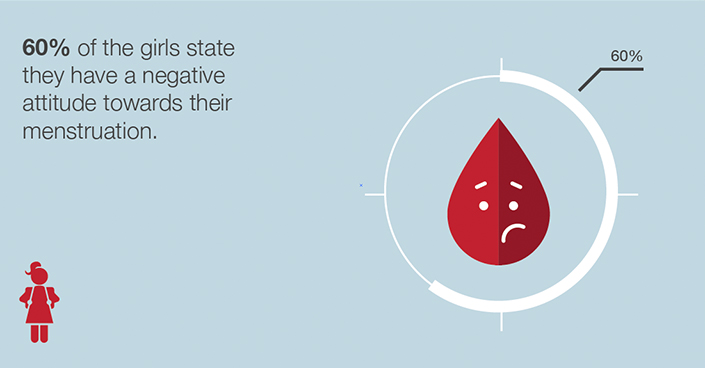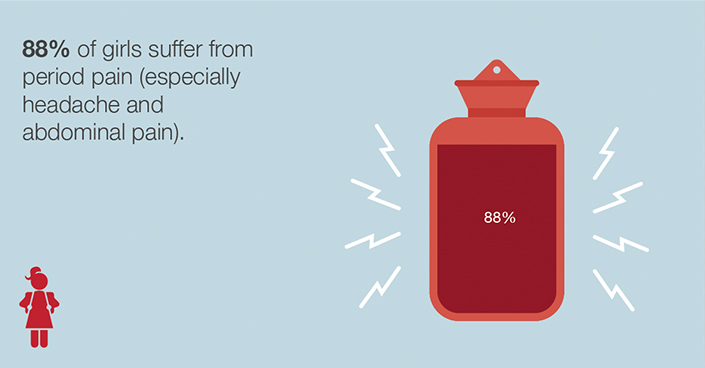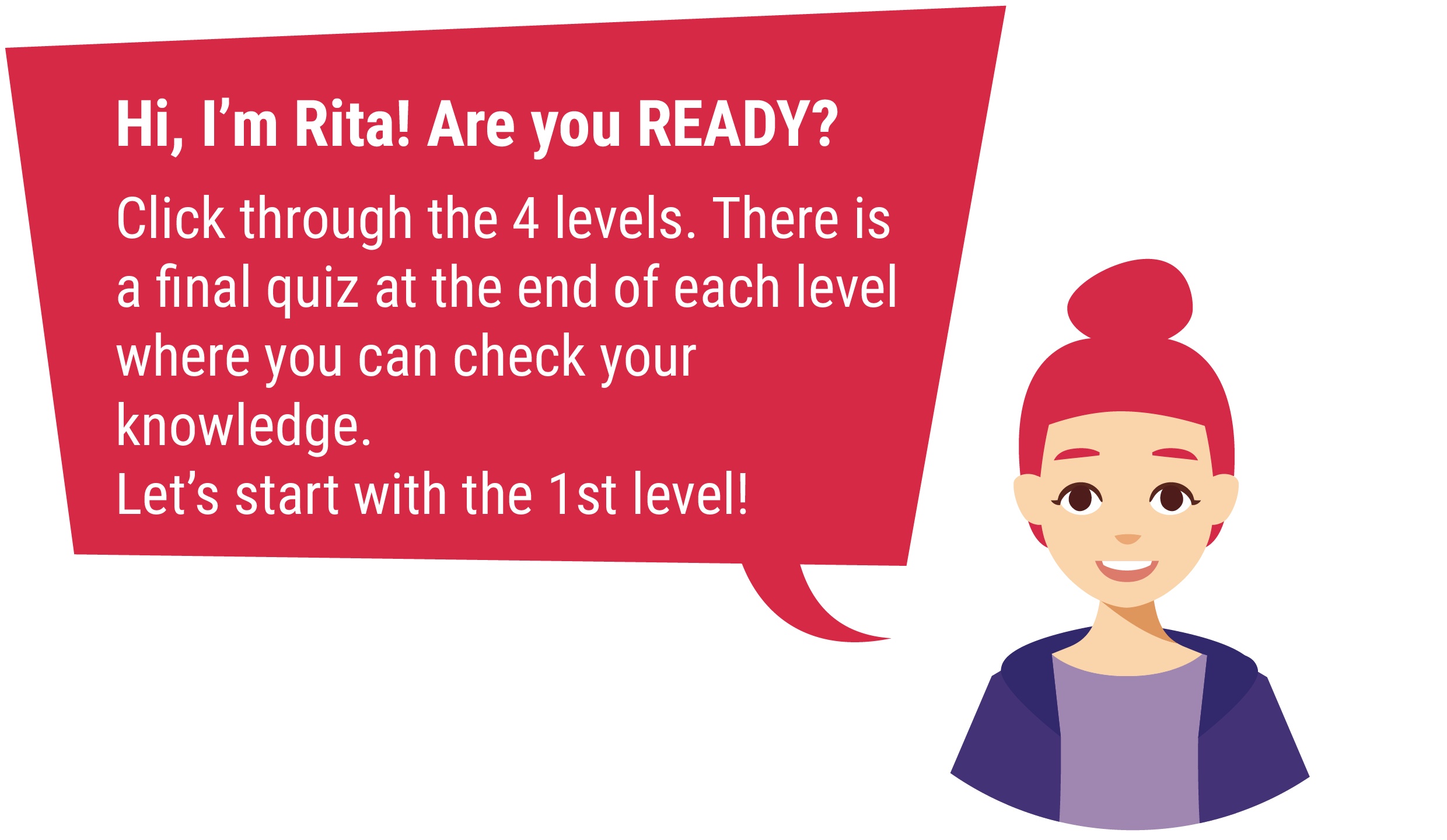Results of a survey among 1.100 teenagers
The first survey about menstruation amongst teenagers shows:
Boys find the subject embarrassing and girls don’t know much about their bodies.
In April/May 2017, we asked 1,100 teenagers aged 13 to 17 years about their knowledge on menstruation and their attitude towards it. This was the start of our project which is aimed at presenting the subject of menstruation to teenagers in an interesting and fun way. This survey is the first representative survey on this subject amongst Austrian adolescents. The results are surprising and somewhat shocking.
From our daily educational work, we know that many girls still consider their period a horrible subject – as opposed to the open and positive attitude towards menstruation that is propagated by the media. The current “menstruation hype”, in particular on social media, where the taboo concerning menstruation is being broken and the period is perceived as something positive, applies mainly to grown women. Young girls still experience the period in a negative way; this is mostly accompanied by a negative body image.
The facts regarding the survey
- Survey period: April-May 2017
- The respondents were: Austrian adolescents (girls and boys) aged 11-18 (core target group: 13 to 16-year olds)
Basic population: 1,109 adolescents (684 girls, 425 boys) - Survey tool: Online questionnaire (with programme software: SoSci -> anonymous data processing guaranteed, as the tool does not store IP-addresses or other personal data).
- Random sampling: contact via group leaders (clubs, school classes, youth clubs). To allow anonymous participation in the survey, on the one hand, and to ensure participation of the desired target group (boys and girls aged 11 to 18 years or core target group 13-17 years) in the survey, we asked schools, educators and heads of youth centres to carry out the survey with adolescents. The majority of adolescents took part in the survey on their own smart phones, some used school computer rooms to participate.
- Structure of the questionnaire: Sectors: Knowledge, handling, education, gender-specific questions
The results:
Attitude: “Menstruation is embarrassing!”

- 60 % of the girls state they have a negative attitude towards their menstruation.
- 70% of boys consider the subject of menstruation unimportant and embarrassing.
The level of knowledge is even worse than the attitude. The purpose of the survey, which was conducted in an anonymised online format, was to examine if traditional sex education deals with the subject of menstruation in a satisfactory manner. Conclusion: There is a lot of catching up to do!
Level of knowledge: Over 50% “failed” with regards to basic menstruation knowledge
- 85% of the girls and 88% of the boys feel they have sufficient information about the subject of menstruation, but they have significant knowledge gaps. 17% of the girls and one in three boys do not know what menstruation actually means.
- 53% also believe that menstruation serves the purpose of contraception.
- About half the girls did not know what to make of terms such as the menstrual cycle or cycle length. Amongst the boys this number is as high as 80%. Particularly shocking: More than half the girls do not know how often tampons must be changed. Most girls have never heard of toxic shock syndrome (TSS) and only 13% were able to explain the term.
Period pain: sad daily (school) routine for almost all girls

- 88% of the girls stated they suffer from menstruation symptoms.
- The most common symptoms are headaches and mood swings. One in three girls suffers from stomach cramps. Very few girls confide in their teachers when they suffer from severe period pain at school. At the same time young girls often don’t know what they can do to ease their period problems and who to turn to. Only 10% of the respondents turn to a school doctor, over 60% only talk to a family member and 20% hide their problems.
The fact that girls often feel left alone with their pain and are afraid to talk to someone about it, leads to the affected person being isolated and also constitutes a significant interference with their quality of life and academic performance at school. Particularly controversial: One in three girls suffers from period pain that is so severe that she had to miss school in the past. This shows that there is an urgent need for action for schools to provide more education on this subject. This is why we started the project READY FOR RED and why we consciously address girls and boys, as a real break of the taboo can only be achieved if both genders are sufficiently informed about the subject.
Disposal scandal: 83% of used tampons and sanitary towels end up in the (school) toilet

- 73% of girls mainly use sanitary towels, 44% use tampons
- More than one in three girls knows the menstrual cup, yet only 2% use menstrual cups
- 83% of girls throw their used menstrual hygiene products into the toilet
The fact that more than 4/5 of all girls dispose their used hygiene products in the toilet rather than the waste bin is an ecological as well as an economic disaster. Conventional tampons and sanitary towels often contain plastic, chemicals and synthetic additives and do not disintegrate when flushed down the toilet. They end up directly in the waste water and are extremely costly for sewage treatment plants. Often special macerators need to be installed to protect the plants from so-called solid substances like tampons and sanitary towels. At erdbeerwoche, we are convinced this could be avoided easily if, on the one hand, girls were educated about this problem and, on the other hand, they stopped being embarrassed about disposing their hygiene products in waste bins outside the toilet. In response to the question why they dispose their menstrual products in the toilet, nearly 20% said there were no waste bins next to the toilets and 25% said they found disposing their hygiene products outside the toilet embarrassing. In view of these figures, it almost seems logical that only one in three girls has thought about the effects of menstrual hygiene products on the environment. For this reason, READY FOR RED, in cooperation with the Federal Ministry of Sustainability and Tourism’s water youth platform, Generation Blue, initiated the campaign PERIODS FOR FUTURE.
First conclusion: there is a severe need for education
The results of the survey show huge gaps in basic knowledge about menstruation – amongst girls and boys. This suggests that the subject of menstruation is not adequately dealt with in class. Certain subjects such as correct handling of menstrual products or the health and ecological effects of these products are barely mentioned at all. The adolescent respondents’ predominantly negative attitude to the subject of menstruation is also shocking. In conclusion, the results suggest that menstruation is still a massive taboo in our society, especially amongst adolescents. There is a significant need for education and the way these subjects are conveyed requires an urgent overhaul. With the project READY FOR RED, erdbeerwoche wants to promote this education and contribute to breaking the taboo about menstruation.
There is hope
BUT: There are also positive trends! Even though more than 60% of girls have a negative attitude towards menstruation, the majority of respondents associate terms such as “female”, “adult” and “normal” with their period. The subject of menstruation appears to have a negative connotation for many girls, yet at the same time they are at least somewhat aware of the period’s basic function as a sign of a healthy cycle and fertility. Our project READY FOR RED wants to tap into this positive trend and educate girls and boys about the secrets of menstruation and everything that comes with it.
Menstruation as an (un-) popular topic
The survey of 1,100 Austrian adolescents showed that 53% of girls have no problem talking about menstruation. On the other hand, nearly 18% felt uncomfortable talking about it and would rather avoid the subject. Girls are most likely to discuss their periods with their girlfriends, closely followed by their mothers, as the people they trust and can talk to. Girls’ most popular sources of information on the subject of menstruation are family (62%), internet (32%) and school (10%). This result confirms that menstruation and menstrual hygiene are treated as marginal subjects in school lessons; the result of our knowledge questions also confirms this: more than half the girls do not understand the meaning of terms such as the cycle, cycle length or toxic shock syndrome. As a result, girls obtain the information they need from alternative sources, the internet being top of the list. The internet is full of semi-truths, as well as worrying false information in various forums for girls, therefore the need for comprehensive education at school becomes even more pressing.
The subject of menstruation is not openly approached within the family
Boys also have spectacular knowledge gaps. 53% of boys believe that girls’ menstruation serves the purpose of contraception. In this context, it is not surprising that 93% of the boys reported that the subject of menstruation is not openly discussed within their families. Almost 30% of the boys think, however, that the best way to provide education about the subject of menstruation is a via school; this in turn shows that sex education in this sector must be improved.
Boys are familiar with period problems and want to support girls.
Finally, the positive outlook: Even if boys have significantly less basic knowledge about menstruation than girls, they have quite a good idea about period problems. According to the survey almost 90% of the respondents amongst the girls suffer from period pain, the main problems are headaches, stomach pains and mood swings. Boys also suggested these as the most common menstruation symptoms and thus showed they are better informed than expected.
Particularly pleasing: 52% of the boys stated they would be happy to support girls who are suffering from acute period symptoms. We would like to use READY FOR RED to show adolescents how to achieve this.
The development of the project is funded by the National Foundation for Research, Technology and Development.










